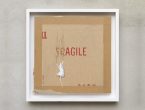A.P. (no.1)
2012 - Photography (Photography)
Erin Shirreff
Erin Shirreff’s A. P. series of prints investigates how objects are “constructed” at the level of the image. For each composite photograph, Shirreff fabricates two sculptural forms from what appear to be metal or plaster, although the precise materials are unidentified. Her sculptures resemble miniature architectural models or renderings of buildings as-yet-to-be fully conceptualized, both elemental and elegant in their use of sharp angles and clean lines. Shirreff then photographs each object against a similarly monochromatic backdrop in her studio, printing each image in rich and high-contrast greyscale. Next, she folds each print in half vertically so that the objects depicted in the image appear to be bisected. Finally, she adjoins the two folded prints at the edge of the fold, creating a new pictorial form from the two bisected images. The hybridized forms depicted in her prints resemble a jarring juxtaposition of geometric sturdiness and malleable plasticity, a cross between Tony Smith’s monolithic minimalism and Alexander Calder’s surreal wiriness. Shirreff uses photography here to imagine sculptural forms that do not exist in real life, and her work employs an illusionistic quality indebted to artistic traditions of trompe l’oeil. But Shirreff also reveals the artifice behind these images, suggesting that all pictorial representations are constructed and, in effect, can never fully document or replicate the experience of encountering an object in “real” perceptual space.
Erin Shirreff creates composite images that interrogate presumed boundaries between artifice and documentary. Originally trained as a sculptor, she works in the expanded field of photography, video, and sculpture, and her practice frequently employs multiple fine arts disciplines at once. Her work reconsiders the limits of sculptural practice by showing how image-based media can effectively be used to render hybridized shapes that do not (and arguably cannot) exist in real life. At the same time, she also reveals how these images are always deliberately constructed, leaving fold lines exposed and obvious discontinuities and aberrances in her composites. In leaving these artificial traces behind, Shirreff’s reminds us that images are always fabricated on some level and that representation itself is an artifice at its core.
Colors:
Related works featuring themes of: » Canadian, » Chance, » Curvilinear Forms, » Film/Video
» see more

© » KADIST
Rodney Graham
1991Ponderosa Pine IV belongs to a series of large-scale photographs of trees taken by Graham and depicts a particular species that live in Northern California...

© » KADIST
Rodney Graham
1996Tree on the Former Site of Camera Obscura (1996) belongs to a series of large-scale photographs of trees taken by Graham and depicts a particular species that lives in Northern California...
Other related works, blended automatically
» see more

© » KADIST
Rodney Graham
1991Ponderosa Pine IV belongs to a series of large-scale photographs of trees taken by Graham and depicts a particular species that live in Northern California...

© » KADIST
Rodney Graham
1996Tree on the Former Site of Camera Obscura (1996) belongs to a series of large-scale photographs of trees taken by Graham and depicts a particular species that lives in Northern California...
Related works sharing similar palette
» see more

© » KADIST
Emma Wolukau-Wanambwa
2005A short video about Tate Modern by Emma Wolukau-Wanambwa depicts just two shots, both featuring the artist...

© » KADIST
Andrea Bowers
2010The small drawings that comprise Study from May Day March, Los Angeles 2010 (Immigration Reform Now) and We Are Immigrants Not Terrorists are based on photographs taken at a political rally in downtown Los Angeles in which thousands of individuals demonstrated for immigrants’ rights...

© » KADIST
Adrian Villar Rojas
2010The two drawings in the Kadist Collection are part of a larger series entitled Las Mariposas Eternas (The Eternal Butterflies)...
Related artist(s) to: Erin Shirreff » Alex Hubbard, » Allyson Vieira, » Amy Granat, » Barbara Kasten, » Chino Otsuka, » Chris Wiley, » Danh Vo, » Daniel Lefcourt, » David Weiss, » Doug Aitken
» see more

© » KADIST
Barbara Kasten
2008Barbara Kasten’s Studio Construct 51 depicts an abstract still life: a greyscale photograph of clear translucent panes assembled into geometric forms, the hard lines of their edges converging and bisecting at various points...

© » KADIST
Doug Aitken
2009The version of Frontier acquired by the Kadist Collection consists of a single-channel video, adapted from the monumental installation and performance that Aitken presented in Rome, by the Tiber River, in 2009...
Related works found in the same semantic group
» see more

© » KADIST
John Houck
2013Untitled #242 is part of Houck’s Aggregates Series, which uses digital tools to manipulate chosen sets and pairs of colors, creating colorful index sheets, bathed in colors and lines...

© » KADIST
James Welling
2005#17 Pink is a photogram, a photographic image produced without the use of a camera...

© » KADIST
Clarissa Tossin
2012In Fordlândia Fieldwork (2012), Tossin documents the remains of Henry Ford’s rubber enterprise Fordlândia, built in 1928 in the Brazilian Amazon to export cultivated rubber for the booming automobile industry...

© » KADIST
Glenn Ligon
2000Glenn Ligon’s diptych, Condition Repor t is comprised of two side-by-side prints...







